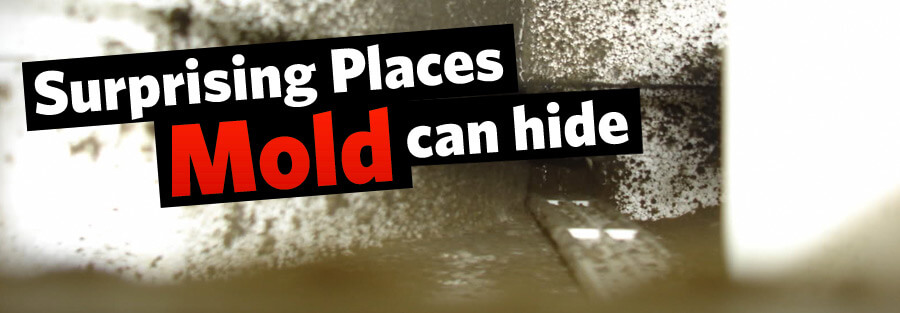Three words I never want to hear together: surprise, mold, and hiding. Mold is not very high maintenance and can appear and then multiply in a blink of an eye. The right mix of moisture or humidity and a little dust or pollen (aka the inside of your HVAC system) and there you have it, places mold can hide.
It is a common fact that mold will make you sick if exposed over extended periods of time. People notice increased respiratory issues or asthmatic flares that will not go away or will experience persistent headaches or sinus infections that last for months. Mold and other bacterial growth can occur in many places inside your home like your bathroom, refrigerator, and even the soil in your potted plants. However, I am just going to talk about one culprit of mold growth — the HVAC system.
Surprising Places Mold Can Hide in Your HVAC System: Part 1
The Evaporator Coil: The evaporator coil is located inside your home near the furnace or air handler. Warm air is pushed over the evaporator coils and is then transferred throughout your home via the blower. Naturally, condensation is produced here, falls into the drip pan and drains out of your home. If there is a problem with any part of this process, the moisture will build up and create an environment fit for mold.
Surprising Places Mold Can Hide in Your HVAC System: Part 2
Ductwork: The ductwork throughout your home can be considered a fresh air highway that circulates the cold or warm air produced by the HVAC system. Dust and pollen spores (among many other pollutants) also travel this highway and are forced to exit into the air filter or purifier except if there is excess moisture. Excess moisture can occur in ductwork if there is any type of leak: roof, plumbing, or improper bathroom venting. Mold spores will form in this environment if the leak or excess moisture problem is not fixed.
Surprising Places Mold Can Hide in Your HVAC System: Part 3
How to prevent mold:
- Eliminate: Yes, I am going to say it again; annual maintenance, annual maintenance, annual maintenance. Our qualified HVAC technicians will inspect, repair, and clean your HVAC unit, ensuring clean, dry, and efficient function.
- Check: If you suspect a leak anywhere in your home, it won’t stop until it is repaired. Hire a qualified professional to inspect and repair as soon as possible.
- Install: Install a clean air filter if necessary to lessen the amount of dust and pollen in the ductwork or install the most efficient air filter, an air purifier. An air purifier purifies the air passing through it, eliminating airborne irritants, viruses, smaller mold spores and other bacteria.
Surprising places mold can hide in your HVAC system really shouldn’t be a surprise at all. With proper maintenance and care of both your HVAC system and your home, preventing or at least combating mold will occur naturally.




